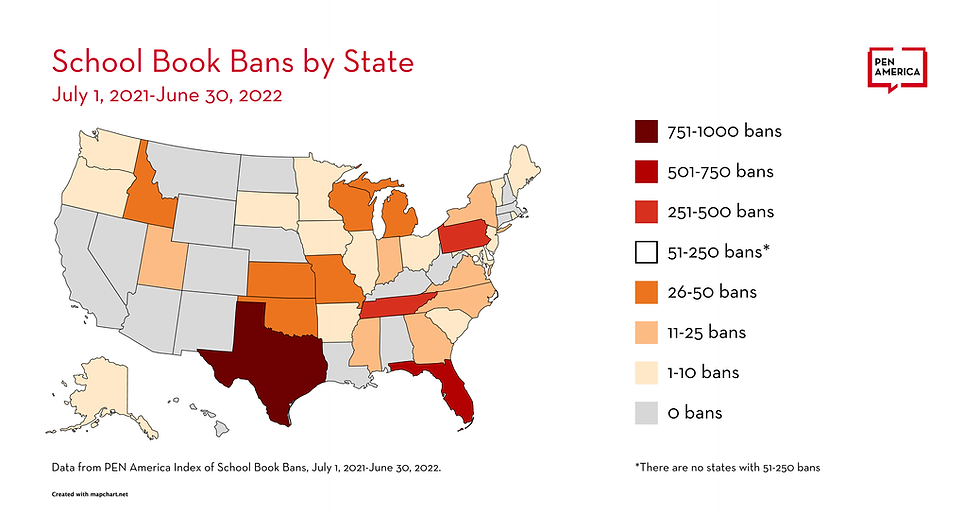Why Book Bans?
- voicesofgenz
- Aug 23, 2023
- 2 min read
By: Ethan Kishan

An infographic explaining the increase in book bans across the US
Book banning is quickly becoming one of America’s most contested political issues as conservatives pull books from shelves under the guise of protecting children from “inappropriate material” (“2023”). After a library in San Diego refused to take down its Pride book display, two residents checked out most of the books to keep children from reading them (Cowan). Across the country, efforts to ban books doubled in 2022, and have jumped roughly 30% in the first half of 2023 (Alter; “2023”). Students in Texas, Florida, Missouri, Utah, and South Carolina may have a harder time finding books featuring characters of color, queer relationships, or feminist narratives (Smith).
But why are conservatives so worried about this so-called “inappropriate material” in books? On paper, conservatives list “sexual content,” “excessive violence” and “cruel language” but the truth is simple: they want their children to live in an echo chamber.
Book banning in the United States has often targeted books that make the privileged uncomfortable: books like I Know Why the Caged Bird Sings by Maya Angelou, a narrative that centers around black feminity and the intersection of race and gender, or The Adventures of Huckleberry Finn by Mark Twain, a surprisingly progressive book for its time featuring a black main character and decidedly anti-slavery themes (Webb).
Books allow readers to peek into someone else’s mind and see the world from their point of view. They allow readers to see how different people move through the same world; how the systems in place might benefit the reader but harm others. They allow readers to recognize their own privilege.
They also allow readers to explore different parts of their identity from the safety of their homes. Gender Queer, one of the most banned books in the United States, opened up conversations between parents and questioning children that would’ve festered otherwise (Kobabe).
This is the crux of the conservative mission: remove these avenues for self-reflection, and keep their children moldable to their racist, misogynist, and homophobic views. With no chance to learn better, these children will grow up spouting hate with no clue they are wrong.
Following the passing of HB 3979 in Texas, more than 400 books were removed from San Antonio school district libraries (Garcia). HB 1557 in Florida, the “Don’t Say Gay” bill, prompted classrooms across the state to remove LGBTQ+ books (Florida). Dozens of school districts across the country have instigated their own book bans, with no national legislation against it.
Still, there is hope: Illinois recently banned book bans, laying the foundation for a possible nationwide law. The San Diego library received $15,000 in donations from the community in support of LGBTQ+ programming (Cowan). Organizations like the American Library Association, PEN America, and the Comic Book Legal Defense Fund work tirelessly to combat censorship and book banning. Additionally, Libraries across the country continue to spotlight queer and POC narratives, undeterred by negative responses.
As this issue evolves through election season, remember what conservatives hope to achieve when they mention book banning. And remember: any book worth banning is a book worth reading.
Written by intern Ethan Kishan

Comments